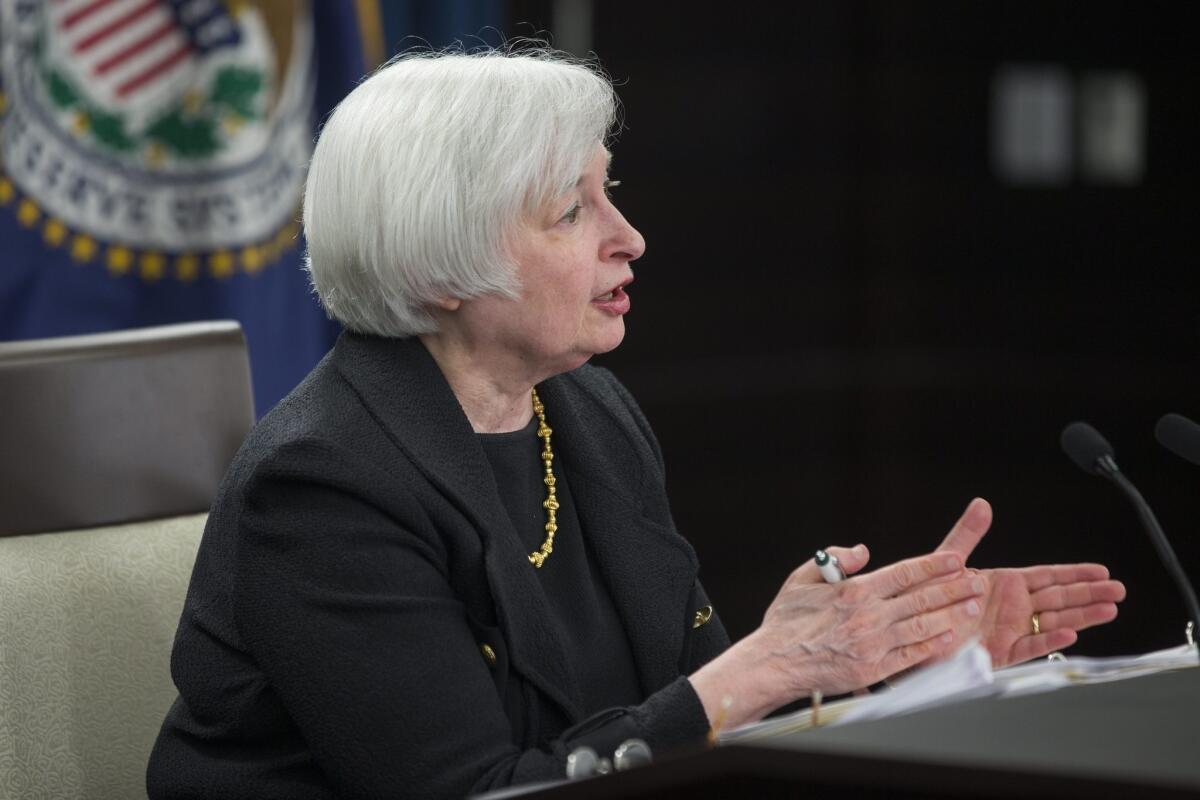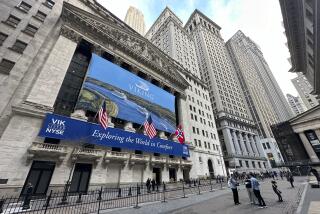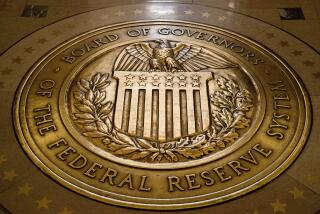Fed declines to raise interest rate amid global market turmoil

Federal Reserve Chair Janet Yellen speaks at a press conference after announcing that the Federal Reserve will not raise interest rates.
Cautious Federal Reserve policymakers on Thursday held a key interest rate at near zero, opting to wait longer to remove the unprecedented easy-money stimulus to determine whether recent global financial market volatility has slowed the U.S. economy.
While domestic conditions have improved and there have been “solid job gains and declining unemployment,” Fed officials expressed concerns about low inflation along with the tumult on Wall Street and abroad.
“Recent global economic and financial developments may restrain economic activity somewhat and are likely to put further downward pressure on inflation in the near term,” the policymaking Federal Open Market Committee said in a statement.
Low inflation — driven recently by the sharp drop in oil prices — is a drag on workers’ income and could hold back U.S. economic growth.
Still, Fed policymakers signaled the rate would be raised by the end of the year.
The statement surprised experts, who described it as very “dovish” on a future rate hike. Many analysts had expected the Fed to hold the rate steady but figured that decision would be coupled with a fairly strong statement of imminent action.
“At the end of the day, I did not think they would move; but I thought that they would signal that a move was perhaps closer than it had been before,” said Carl R. Tannenbaum, executive vice president and chief economist at Northern Trust in Chicago.
“But the language in the statement around international developments seems to reveal a state of concern that’s going to really weigh on the group as they proceed through the remainder of the year,” he said.
Chris Rupkey, chief financial economist at the Bank of Tokyo-Mitsubishi in New York, said the decision “will be seen by many as appropriate.”
“Although the domestic economy appears to be in sound health, current worries about slowing growth outside of the U.S., notably China, and recent financial market turmoil meant the Fed decided on balance that it’s not a good time for the first U.S. rate hike in almost a decade,” Rupkey said.
“But the lack of action leaves lingering uncertainty about the outlook for U.S. policymaking, which will no doubt fuel further volatility in the markets,” he said.
The Fed’s decision Thursday came amid high anticipation that policymakers would enact the first increase in nearly a decade in the so-called federal funds rate.
The short-term rate, a benchmark for consumer and business loans, has been held near zero since late 2008 to help boost the economy during and after the Great Recession.
Fed policymakers said Thursday they were “monitoring developments abroad” and their economic projections showed that most expected a rate hike by the end of the year.
But Fed Chairwoman Janet L. Yellen and all but one of her colleagues decided to move cautiously this month amid a lack of data on the effects of the recent financial market turmoil.
Many experts have warned a rate hike now could add to the volatility.
Jeffery M. Lacker, the president of the Federal Reserve Bank of Richmond, Va., dissented in the 9-1 vote. He wanted to raise the rate by 0.25 percentage points, the statement said.
Fed officials slightly upgraded their projections for economic growth this year, to 2.1% from a 1.9% estimate in June.
But they downgraded their projections somewhat for the next two years, with growth forecast to be 2.3% next year and 2.2% in 2017, continuing the sluggish pace that has marked the recovery from the Great Recession.
The unemployment rate is forecast to drop to 5% by the end of the year, much better than the 5.5% Fed policymakers projected in June. It’s forecast to fall further, to 4.8%, by the end of 2016.
But inflation will remain even lower than forecast in June. Fed officials projected it would be just 0.4% this year and not hit the central bank’s annual 2% target until 2018 — a year later than they expected in June.
Fed policymakers also downgraded their projections of what the rate would be at the end of the year. Now, just one of the 17 official expected the rate to be above 0.75 percentage point by year’s end, compared with five who had projected that level in the June forecast.
While 13 policymakers expected a rate hike this year, three thought the move would not come until next year — and one doesn’t expect it until 2017.
Fed policymakers appeared on track for a September rate hike as the labor market continued to show solid growth this year.
Despite annual inflation running below the Fed’s 2% target, the central bank has been under pressure to start pushing rates up toward a normal level before the easy money causes prices to jump.
But the calculations got complicated when China devalued its currency last month, a sign of a slowdown in that nation’s economy that rattled global financial markets.
There has been concern that a rate hike now by the globe’s most influential central bank could further roil the markets.
The World Bank’s chief economist recently warned that the Fed risked “panic and turmoil” in emerging-market economies if it raised the rate. And liberal activists have pushed the Fed to hold off until the labor market is stronger and producing better wage growth.
Follow @JimPuzzanghera on Twitter
More to Read
Inside the business of entertainment
The Wide Shot brings you news, analysis and insights on everything from streaming wars to production — and what it all means for the future.
You may occasionally receive promotional content from the Los Angeles Times.












